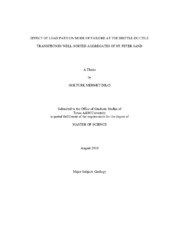| dc.contributor.advisor | Chester, Frederick M. | |
| dc.creator | Dilci, Gokturk Mehmet | |
| dc.date.accessioned | 2010-10-12T22:31:44Z | |
| dc.date.accessioned | 2010-10-14T16:07:19Z | |
| dc.date.available | 2010-10-12T22:31:44Z | |
| dc.date.available | 2010-10-14T16:07:19Z | |
| dc.date.created | 2010-08 | |
| dc.date.issued | 2010-10-12 | |
| dc.date.submitted | August 2010 | |
| dc.identifier.uri | https://hdl.handle.net/1969.1/ETD-TAMU-2010-08-8219 | |
| dc.description.abstract | Granular aggregates of quartz subjected to triaxial compression under constant
effective pressures (Pe) undergo macroscopic failure at critical stress states that depend
on the effective mean stress. Although the mode of failure and mechanical response vary
systematically with mean stress at failure, prefailure loading at subcritical stress states
may induce yielding, and subcritical load paths may influence behavior at failure. Here,
I investigate how the failure of quartz aggregates at conditions favoring compaction
depends on consolidation history and load path in the transitional and ductile
deformation regimes in terms of strain localization and microfracture fabric. Three
distinct non-standard triaxial compression load paths were employed; the paths involve
different preconsolidation of the aggregates at subcritical isotropic stress followed by
differential loading with increasing or decreasing confining pressure. Deformed
aggregates were injected with epoxy and studied using optical microscopy techniques to
determine microscopic damage evolution for the different load paths. Microfracture data
show that preconsolidation at subcritical isotropic loads facilitates formation of
campaction bands during subsequent triaxial compression in the transitional regime.
The preferred orientation of intragranular cracks evolves from near random fabrics for
isotropic loading to strongly preferred orientations parallel to the maximum principal
compression direction for differential loading, with the strongest preferred orientation
within the compaction bands. Aside from the preconsolidation, different load paths have
only a minor effect on the mechanical response during macroscopic failure. | en |
| dc.format.mimetype | application/pdf | |
| dc.language.iso | en_US | |
| dc.subject | Load Path | en |
| dc.subject | Compactional Deformation Bands | en |
| dc.subject | Consolidation | en |
| dc.title | Effect of Load Path on Mode of Failure at the Brittle-ductile Transition in Well-sorted Aggregates of St. Peter Sand | en |
| dc.type | Book | en |
| dc.type | Thesis | en |
| thesis.degree.department | Geology and Geophysics | en |
| thesis.degree.discipline | Geology | en |
| thesis.degree.grantor | Texas A&M University | en |
| thesis.degree.name | Master of Science | en |
| thesis.degree.level | Masters | en |
| dc.contributor.committeeMember | Kronenberg, Andreas K. | |
| dc.contributor.committeeMember | Ayers, Walter B. | |
| dc.type.genre | Electronic Thesis | en |
| dc.type.material | text | en |


